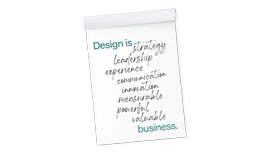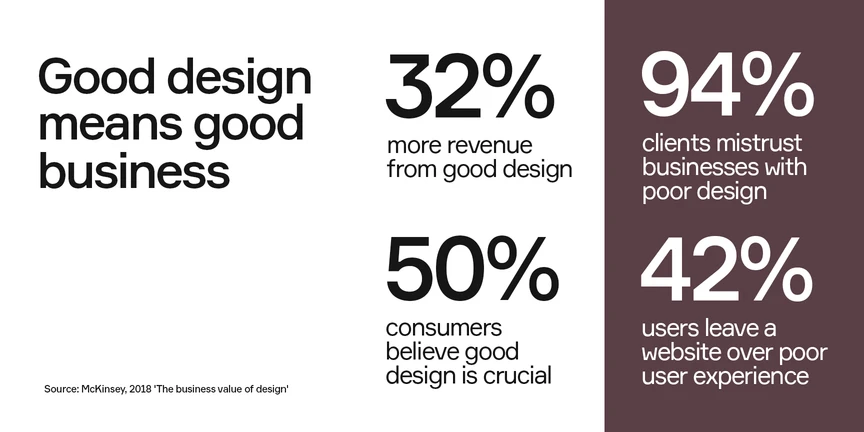How to measure the impact of design
Good design is key to business success. It can increase customer satisfaction, boost sales, and help create business value. But how can we measure success in design?

To begin with, let’s define “design.” Just like strategy, analytics and concept, design is a term that suffers from misuse. Yes, as designers, we define how a product or service looks and feels, but more important how it functions and how it meet users needs and aspirations. Design is a collaboration between creatives and a client to solve a problem in business. And, of course, good design is a positive experience.
The competitive business landscape is fierce, users are more savvy with higher expectations, yet their attention spans are shrinking — and most critically, their patience for bad experiences are at an all time low. It’s easy to see why poor design can result in high costs down the road when disappointing user experiences and inconsistent brand perception can lead to lost customers and opportunities. Good design, on the other hand, ensures that a product or service aligns with users needs, gives them an helpful and enjoyable experience and communicates your brand values. Good design isn’t just beautiful – it’s powerful!
The business value of design
In the McKinsey 2018 report: “The business value of design”, which tracked 300 publicly listed companies across industries over a five-year period found that the correlation between incorporating design thinking and revenue growth was clear. A key finding was that companies that performed the best in design, achieved average revenue growth that was 32% higher than their peers over five years.

In a 2016 research report by Forrester it was stated that “on average, every dollar invested in design brings 100 dollars in return”. Even if the exact numbers have changed since then, these insights can’t be ignored.
This suggests that improving your design capability can improve your company’s financial performance - whether you are making physical products, digital apps, services, experiences or a combination of all.
Measure the financial value of design
As designers, we are strong supporters of the idea that good design equals good business. And many companies tend to agree with us. Still, most of them don’t know how to assess the results of their design teams. User experience may seem intangible and difficult to measure. That is not true. There are metrics that assess the effectiveness of design, helping us to understand how design influences business outcomes.
When evaluating the impact of design in a project, it’s essential to focus on usability, engagement, and satisfaction. With the metrics below you can effectively measure the success of your design and its broader impact on business value:
Usability
Usability metrics are primarily based from data gathered during usability testing.
- Success score (Task completion rate) Indicates the percentage of users who successfully complete a specific task, such as creating an account, selecting the correct product, or submitting a request form.
- Task time helps you determine how long (in minutes, seconds, hours, or days) it takes a user to complete a task. Generally, the faster the completion time, the better the result.
- Error rate tracks all wrong actions made during task completion, including slips (incorrect unintentional actions) and mistakes (deliberate but incorrect actions).
Engagement
User engagement metrics reveal how users interact with a digital product, helping identify areas that may require improvement.
- Time on page measures the average amount of time users spend on specific pages.
- Page views indicates the number of pages a user has viewed over a set period, helping you identify which pages engage users and which may be causing friction.
Satisfaction
User satisfaction is a key metric for measuring the success of a design. It reflects how well your solution meets users expectations and goals, while also evaluates their trust and loyalty.
- Net Promoter Score (NPS) represents the percentage of users who would recommend your product.
- Customer Satisfaction Score (CSAT) helps you understand how users perceive your product or specific features.
- System Usability Scale (SUS) makes users respond to 10 questions, rating each on a scale from 1 (strongly disagree) to 5 (strongly agree).
What is usually difficult to understand is that a “good-looking” product is something that is embedded in the way it is made.
Marina Peluso – Senior UX Researcher at Siemens
If you ignore design, you are leaving money on the table
Design is far more than a surface-level aspect of a product or service — it’s a critical business driver and should be a natural part of every company’s leadership. Good design entails a holistic approach, continuous iteration and a focus on outcomes. Those outcomes generate value.
Whether or not you intentionally design the user experience, your users will still have an experience. They will form their opinions and emotions towards your company by interacting with the product or service. If you don’t design this experience, you lose control over how your customers perceive your brand.
If you're still in doubt about whether to invest in design, just remember that fixing design mistakes during development can cost 10 times more, while a post-release fix can cost you up to 100 times more. Investing in design delivers a strong ROI and is definitely worth your attention.

We would like to hear what you think about the blog post